How the health status of Czech forests develops
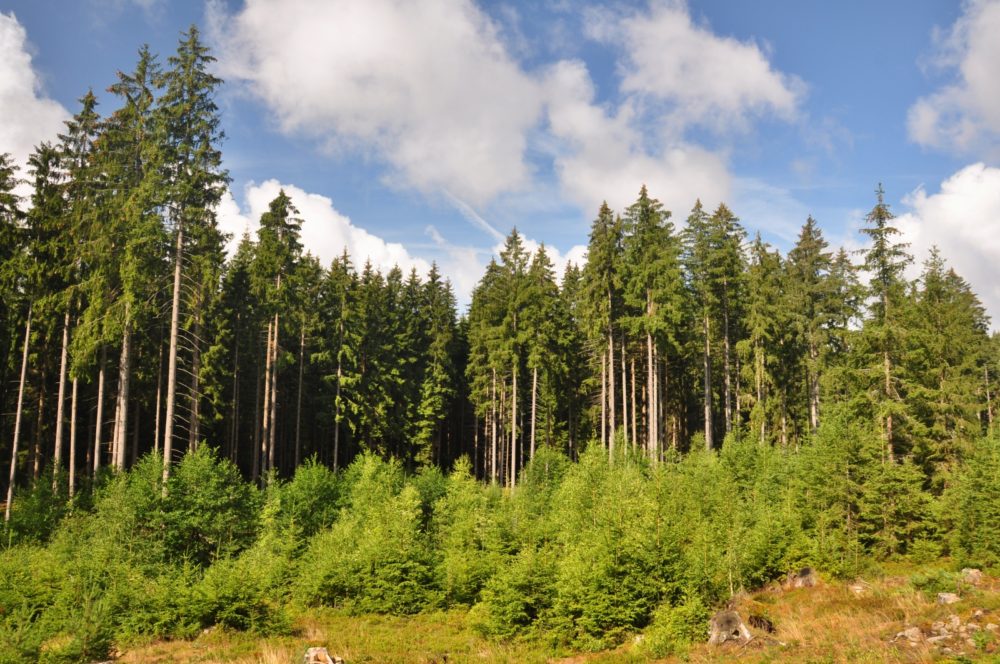 The health status of forests in the Czech Republic has been assessed since 1986, namely at monitoring trials that are part of the European International Cooperative Program for Monitoring and Evaluation of the Impact of Air Pollution on Forests (ICP Forests), which is based on the International Convention on Long–Range Transboundary Air Pollution states, to which the former Czechoslovakia joined in 1984.
The health status of forests in the Czech Republic has been assessed since 1986, namely at monitoring trials that are part of the European International Cooperative Program for Monitoring and Evaluation of the Impact of Air Pollution on Forests (ICP Forests), which is based on the International Convention on Long–Range Transboundary Air Pollution states, to which the former Czechoslovakia joined in 1984.
In the early 1980s, the health of European forests declined sharply due to long–term air pollution. This prompted a need for consistent and coordinated monitoring of their condition at a European level. The program aims to gather information on the spatial and temporal development of the forests’ state and deepen knowledge about the causes of their current damage. It is crucial for understanding the overall health of European forests.
Researching the state of the Czech Republic forests is regularly conducted through monitoring trials. This involves a basic network of 16 x 16 km and selected areas from an 8 x 8 km network, with a total of 306 areas being monitored. These areas are evenly distributed based on forest cover across the country, ranging in altitude from 150 m to 1100 m above sea level. They are strategically placed in forest stands to accurately characterize the specific habitat and vegetation conditions. In 2022, approximately 8.6 thousand trees representing 28 types of forest trees of varying ages were evaluated in these monitoring areas.
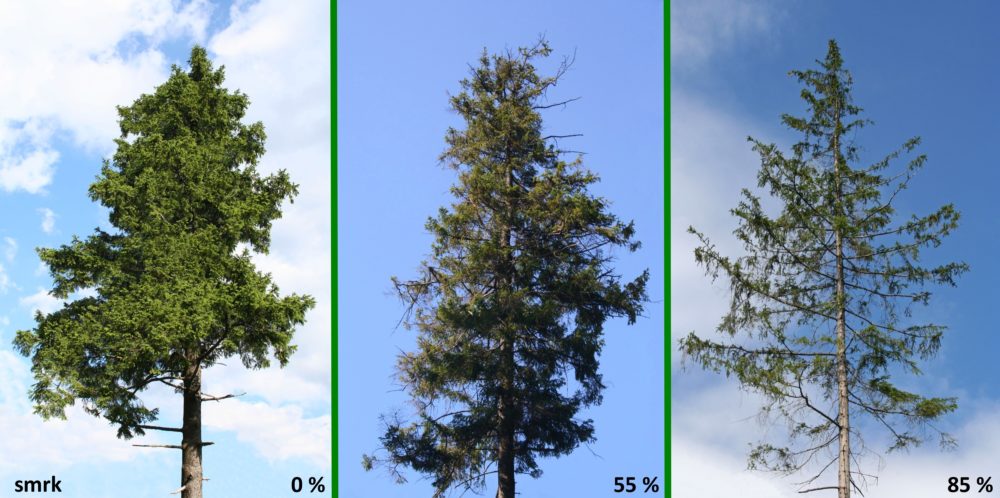 Photo: Sample of defoliation intensity in Norway spruce ranging from 0 % to 85 %., author Petr Fabiánek
Photo: Sample of defoliation intensity in Norway spruce ranging from 0 % to 85 %., author Petr Fabiánek
The health of trees is mainly determined by how much of their leaves have been lost, which is known as defoliation. This is measured by comparing the tree’s assimilation apparatus to that of a healthy tree growing in the same environment. Defoliation is a general symptom of damage to the tree’s crown, caused by various harmful factors having been of both biotic and abiotic origin.
Main trends in the long–term development of coniferous and broadleaf tree species defoliation
Defoliation in older coniferous forests stands has slightly increased since 1998. From 2014 to 2019, there was a significant increase in severely damaged trees, while classes 1 and 2 decreased. However, since 2020, the proportion of severely damaged trees is decreasing, and class 2 is increasing.
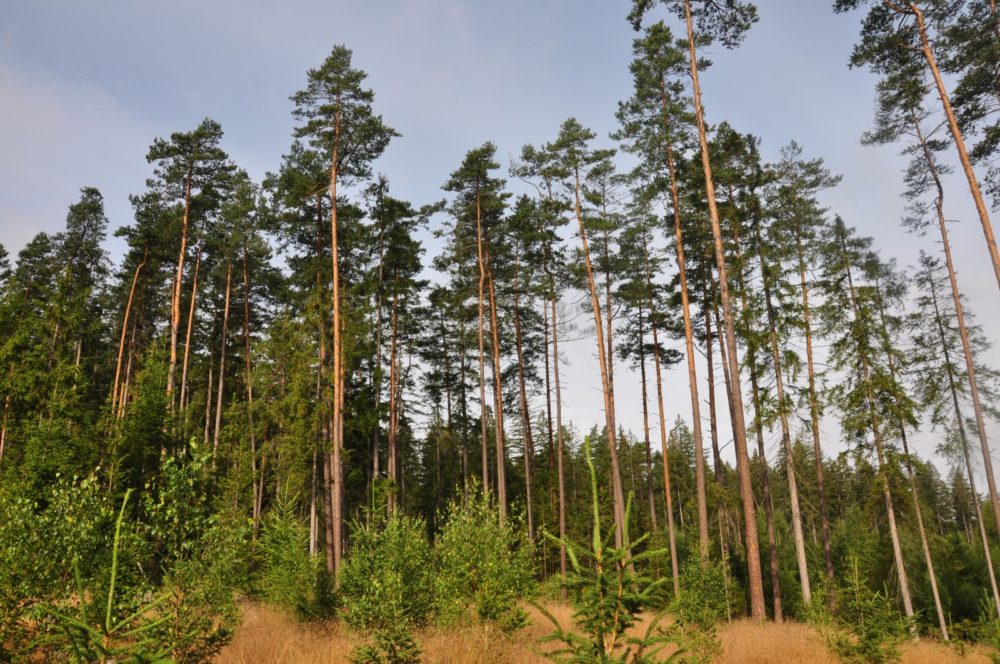 The percentage of healthy trees (0 – 10 %) was not affected by the bark beetle disaster, remaining stable at around 3 %.
The percentage of healthy trees (0 – 10 %) was not affected by the bark beetle disaster, remaining stable at around 3 %.
The slight improvement in adult conifers in 2020–2021 may be due to the decrease in the intensity of the bark beetle disaster and more favourable weather conditions.
From 1998 to 2004, mature Norway spruce defoliation slightly increased. It remained stable until 2015 when the bark beetle caused another increase due to more trees with strong defoliation (above 60 %) and fewer in the lower class (>10–25 %).
Between 2020 and 2021, there has been a noticeable reduction in the number of spruce trees with severe defoliation. Throughout this time frame, healthy trees (classified as 0 –10 %) only make up 1–4 % of the total number of trees observed.
Although there were some positive changes in defoliation patterns among 2010–2014, these improvements were only temporary. The recent extreme drought caused by climate change has had a significant impact on suspending these positive changes.
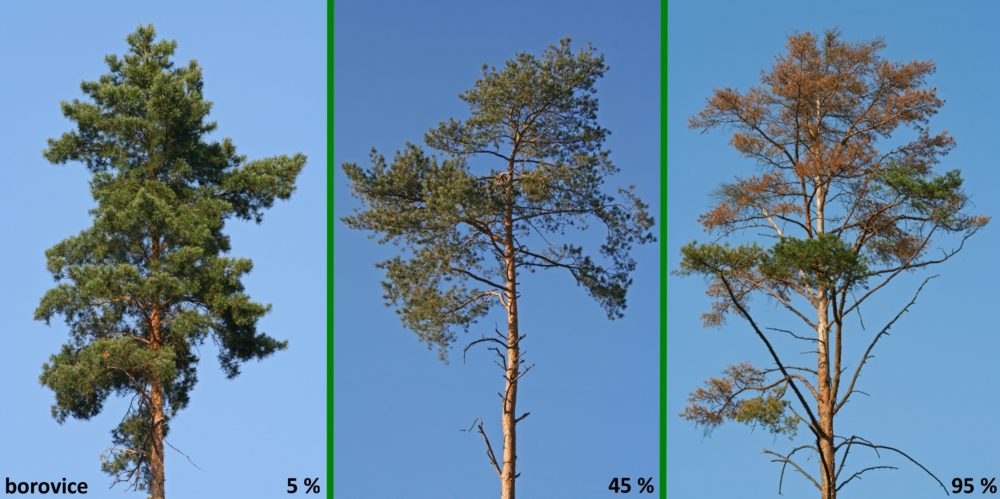 Photo: Sample of defoliation intensity in Scots pine ranging from 5 % to 95 %., author Petr Fabiánek
Photo: Sample of defoliation intensity in Scots pine ranging from 5 % to 95 %., author Petr Fabiánek
For Scots pine, there has been a consistent and gradual rise in defoliation since 1998, with a sharp increase in heavily defoliated trees (over 60%) starting in 2015. This trend peaked in 2019, but the occurrence of severe defoliation in Scots pine has since decreased in the following two years. Throughout the monitoring period, the proportion of healthy trees (with 0–10% defoliation) has remained relatively stable, fluctuating only by tenths to units of a percent.
A distinct increase in defoliation of older deciduous stands since 1998 is changing from 2005 to a very moderate and long–term increase in defoliation with minor fluctuations until 2019. In 2020–2021, there was a slight decrease in defoliation. Healthy trees (0–10 %) have a stable representation in the range of 10–18 % in the period 2000–2022.
Oak defoliation has a greater fluctuation in long–term development and also a significantly higher level than beech defoliation.
From 1998, a long–term rising trend of defoliation is visible for oak until 2009. After that, there is a short–term improvement until 2015 and then an increase in defoliation until its culmination in 2019. A further decrease in defoliation occurs in the years 2020–2022.
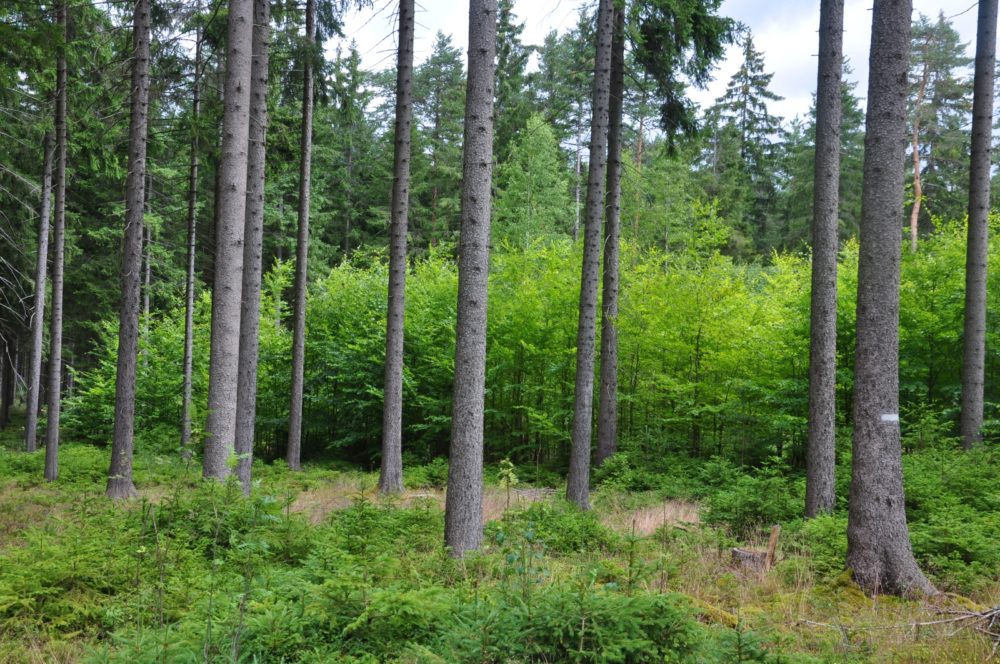 Classes 1 (>10–25 %) and 2 (>25–60 %) have a dominant representation throughout the observation period.
Classes 1 (>10–25 %) and 2 (>25–60 %) have a dominant representation throughout the observation period.
Healthy trees (defoliation 0–10 %) do have a certain representation in each year, but these are low values in the range of 0.5–5 %.
Since 2002, there has been a consistent decline in defoliation among European beech trees following an initial increase. However, after 2005, this trend levelled off and has remained relatively stable with some yearly fluctuations.
For the majority of the monitoring period, categories 0 (0–10 %) and 1 (>10–25 %) have been the most prevalent. Throughout the monitoring period, beech trees have consistently demonstrated the highest percentage of healthy individuals compared to other tree species, ranging from 16–35 %.
Defoliation monitoring results in 2022 and their comparison with previous year
For mature conifers, similar to last year, there was a smaller change in the representation of defoliation in class 2 (>25–60 %), which increased from 70.8 % in 2021 to 72.3 % in 2022, while the representation in classes decreased 0 and 1 (0–10 %, >10–25 %). In case of younger conifers (up to 59 years), there was no significant change in the development of defoliation.
As for Norway spruce, there was a slight deterioration with an increase in the representation of defoliation in class 2 (from 62.8 % in 2021 to 65.2 % in 2022) at the expense of class 0 (a decrease from 5.0 % to 3.7 %).
There was no noticeable change in case of Scots pine compared to last year.
For both main conifer species, this is a slowdown or suspension of the positive trend of a slight decrease in defoliation in the last two years.
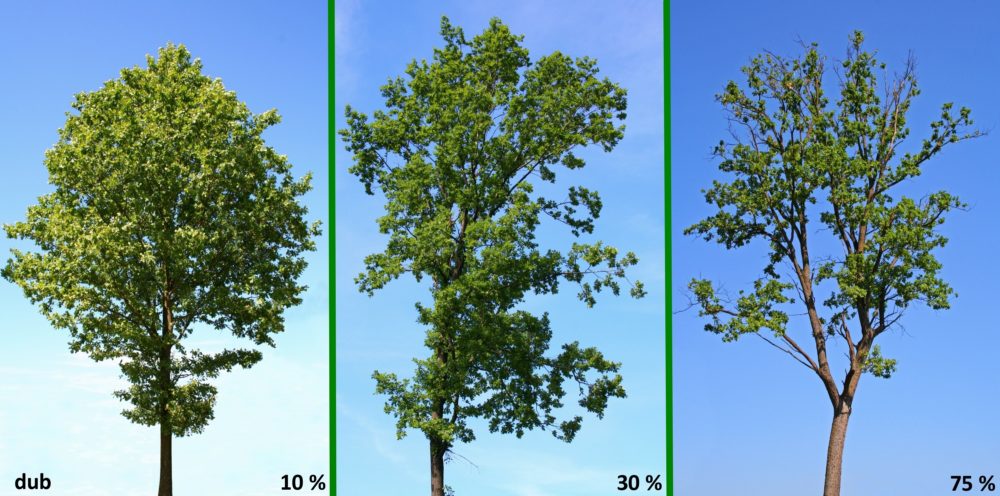 Photo: Sample of defoliation intensity in case of oaks ranging from 10 % to 75 %., author Petr Fabiánek
Photo: Sample of defoliation intensity in case of oaks ranging from 10 % to 75 %., author Petr Fabiánek
In comparison with the previous year, there were no significant changes for deciduous trees in the older age category (over 59 years old). For younger deciduous trees (up to 59 years), there was a very slight improvement in the condition by increasing the representation in class 1 while decreasing the representation of defoliation in class 2.
There are differences between the main species in the age category of older deciduous stands. For oaks, there was a slight improvement in condition with an increase in the representation of defoliation in the lower classes at the expense of the higher classes.
For European beech, a slight improvement in condition continued for the second year, the representation of healthy trees in class 0 increased from 24.6 % in 2021 to 26.6 % in 2022, with a proportional decrease in the representation in classes 1 and 2.
In long–term development, oaks have a dominant representation of defoliation in middle class 2, beech has the largest representation in lower class 1.
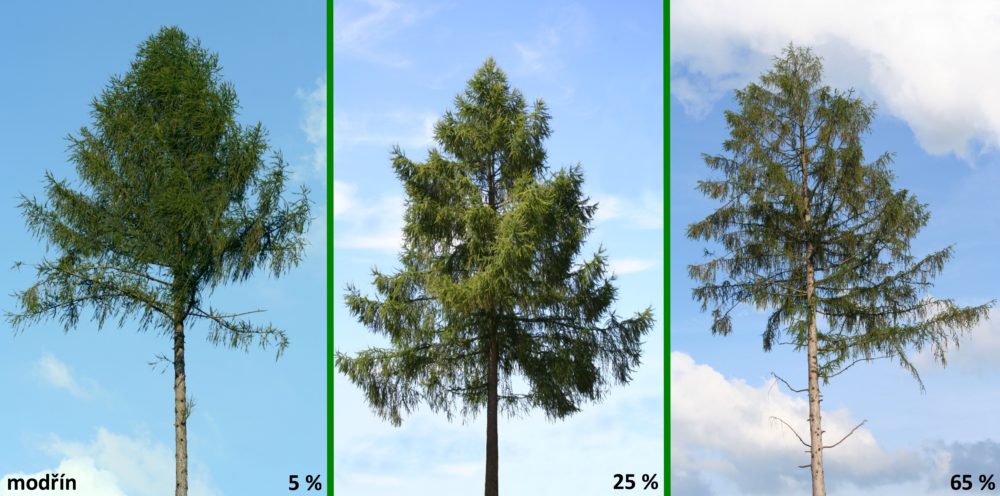 Photo: Sample of defoliation intensity in case of European larch ranging from 5 % to 65 %., author Petr Fabiánek
Photo: Sample of defoliation intensity in case of European larch ranging from 5 % to 65 %., author Petr Fabiánek
Conclusion and outlook
After a culmination of an increase in the prevalence of severe defoliation in most main forest tree species in 2019, there is a distinct decrease starting in 2020. A more favourable course of the growing season with sufficient rainfall had a fundamental influence on this positive change, which continued in 2021 as well. Even though the course of the climate was also favourable in 2022, for most of the main species of forest trees, this positive change was no longer significantly reflected in the decrease in the overall level of defoliation.
Source of information: Forest protection newsletter /Zpravodaj ochrany lesa/, Supplementum 2023 (Occurrence of harmful forest agents in 2022 and their expected status in 2023 /Výskyt lesních škodlivých činitelů v roce 2022 a jejich očekávaný stav v roce 2023/), chapter Monitoring the health of the forest / Monitoring zdravotního stavu lesa/ (author Petr Fabiánek)
Forest protection newsletter /Zpravodaj ochrany lesa/, Supplementum 2023, can be downloaded here.
Prepared by Ing. Jan Řezáč, VÚLHM, v. v. i., e–mail: rezac@vulhm.cz
Illustration photo: The forests in the Ore Mountains are currently considered some of the healthiest in the entire country. Author Jan Řezáč
